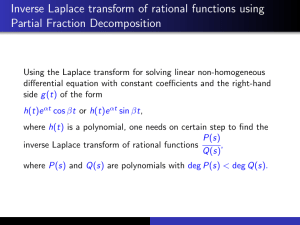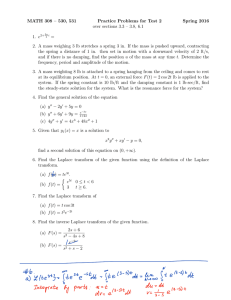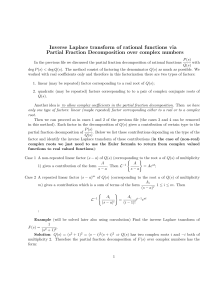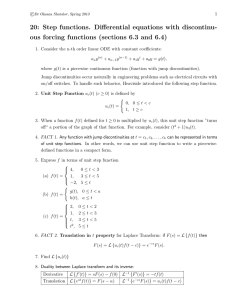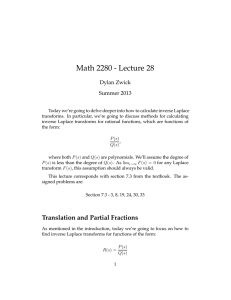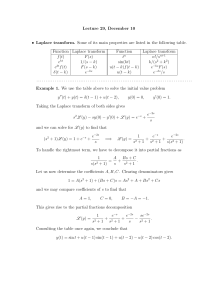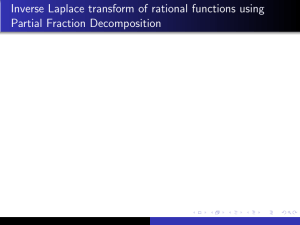Inverse Laplace transform of rational functions using Partial Fraction Decomposition
advertisement
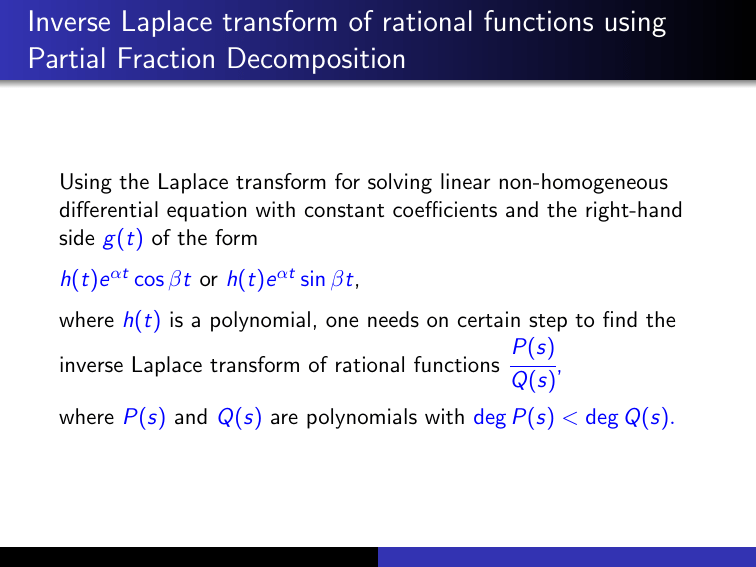
Inverse Laplace transform of rational functions using Partial Fraction Decomposition Using the Laplace transform for solving linear non-homogeneous differential equation with constant coefficients and the right-hand side g (t) of the form h(t)e αt cos βt or h(t)e αt sin βt, where h(t) is a polynomial, one needs on certain step to find the P(s) inverse Laplace transform of rational functions , Q(s) where P(s) and Q(s) are polynomials with deg P(s) < deg Q(s). Inverse Laplace transform of rational functions using Partial Fraction Decomposition The latter can be done by means of the partial fraction decomposition that you studied in Calculus 2: One factors the denominator Q(s) as much as possible, i.e. into linear (may be repeated) and quadratic (may be repeated) factors: each linear factor correspond to a real root of Q(s) and each quadratic factor correspond to a pair of complex conjugate roots of Q(s). Each factor in the decomposition of Q(s) gives a contribution of P(s) certain type to the partial fraction decomposition of . Below Q(s) we list these contributions depending on the type of the factor and identify the inverse Laplace transform of these contributions: Case 1 A non-repeated linear factor (s − a) of Q(s) (corresponding to the root a of Q(s) of multiplicity 1) ) gives a contribution of ( A A the form . Then L−1 = Ae at ; s −a s −a Case 2 A repeated linear factor (s − a)m of Q(s) (corresponding to the root a of Q(s) of multiplicity m) gives a contribution Ai which is a sum of terms of the form , 1 ≤ i ≤ m. (s − a)i ( ) Ai Ai Then L−1 = t i−1 e at ; i (s − a) (i − 1)! Case 3 A non-repeated quadratic factor (s − α)2 + β 2 of Q(s) (corresponding to the pair of complex conjugate roots α ± iβ of multiplicity 1) gives a contribution of the form Cs + D . (s − α)2 + β 2 It is more convenient here to represent it in the following way: Cs + D A(s − α) + Bβ = . Then 2 2 (s − α) + β (s − α)2 + β 2 ) ( A(s − α) + Bβ −1 = Ae αt cos βt + Be αt sin βt; L (s − α)2 + β 2 m of Q(s) Case 4 A repeated quadratic factor (s − α)2 + β 2 (corresponding to the pair of complex conjugate roots α ± iβ of multiplicity m) gives a contribution which is a sum of terms of the form Ci s + D i (s − α)2 + β 2 i = Ai (s − α) + Bi β i , (s − α)2 + β 2 where 1 ≤ i ≤ m. The calculation of the inverse Laplace transform in this case is more involved. It can be done as a combination of the property of the derivative of Laplace transform and the notion of convolution that will be discussed in section 6.6.
